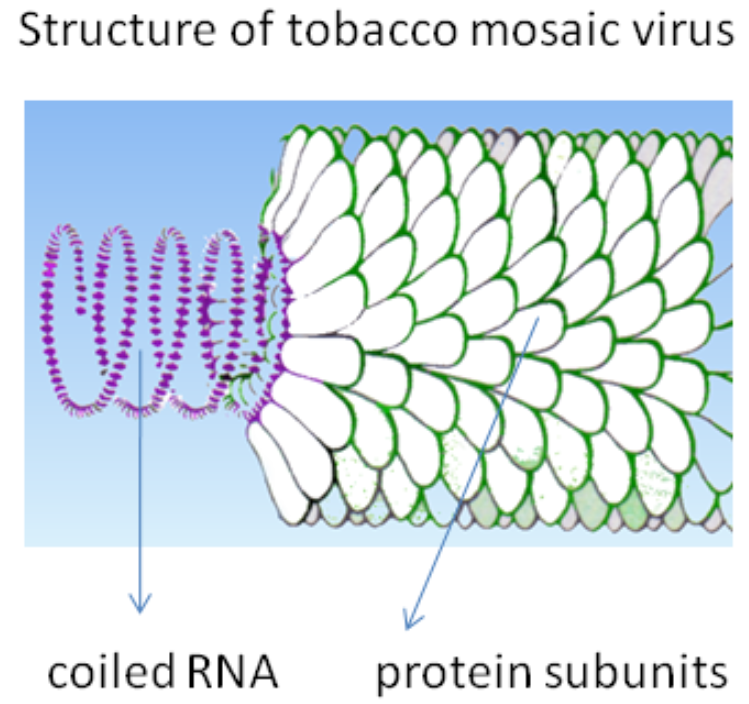
What is TMV?
Answer
571.2k+ views
Hint: The full form of TMV is Tobacco Mosaic Virus. This virus belongs to the genus Tobamovirus. It is a virus that infects many plants, especially plants of tobacco and plants of family Solanaceae.
Complete Answer:
TMV was the first virus that has been discovered. It is a thermostable virus which means it can withstand up to 50 degree celsius temperature for 30 minutes. This virus has a very wide survival range.
Structure of TMV:
- TMV has a rod-like appearance. Its capsid is made from 2130 molecules of coated proteins called capsomeres and one molecule of genomic single stranded RNA.
- All the capsomeres (coat protein) arranged into a rod like helical structure. It consists of 6.3 – 6.5 kb single stranded RNA genomes.
- The 3’-terminus of the genome of this virus has tRNA (transfer ribonucleic acid) like appearance and 5’-terminus of the genome of this virus has a methylated nucleotide cap.

Disease cycle associated with TMV:
TMV infect the tobacco stalks and leaves. First the TMV goes through the infection process and then the replication process.
1. Infection process – After its entry into a particular cell of a plant, it enters the neighbouring cells through plasmodesmata. The infection spreads by direct contact and also by the phloem.
2. Replication process – Following the entry of the virus into the host cell, the virus uncoats itself and releases its genome into the host cell. Then the viral genome replicates itself into the host cell. After the host coat proteins and genome has been synthesised, they spontaneously assemble into complete TMV virions.
Symptoms in host:
- Light discoloration between the veins of young leaves.
- Development of mosaic or mottled pattern of light and dark green areas in the leaves.
- Leaves can be crinkled, puckered or elongated.
Note: TMV virus can be used to engineer viral vectors. Viral vectors are the tools that are used in recombinant DNA technology in order to transfer the desired genetic material into the host cell. It is an ideal candidate to be incorporated into the battery electrodes. The incorporation of TMV into the battery electrodes increases the reactive surface area.
Complete Answer:
TMV was the first virus that has been discovered. It is a thermostable virus which means it can withstand up to 50 degree celsius temperature for 30 minutes. This virus has a very wide survival range.
Structure of TMV:
- TMV has a rod-like appearance. Its capsid is made from 2130 molecules of coated proteins called capsomeres and one molecule of genomic single stranded RNA.
- All the capsomeres (coat protein) arranged into a rod like helical structure. It consists of 6.3 – 6.5 kb single stranded RNA genomes.
- The 3’-terminus of the genome of this virus has tRNA (transfer ribonucleic acid) like appearance and 5’-terminus of the genome of this virus has a methylated nucleotide cap.

Disease cycle associated with TMV:
TMV infect the tobacco stalks and leaves. First the TMV goes through the infection process and then the replication process.
1. Infection process – After its entry into a particular cell of a plant, it enters the neighbouring cells through plasmodesmata. The infection spreads by direct contact and also by the phloem.
2. Replication process – Following the entry of the virus into the host cell, the virus uncoats itself and releases its genome into the host cell. Then the viral genome replicates itself into the host cell. After the host coat proteins and genome has been synthesised, they spontaneously assemble into complete TMV virions.
Symptoms in host:
- Light discoloration between the veins of young leaves.
- Development of mosaic or mottled pattern of light and dark green areas in the leaves.
- Leaves can be crinkled, puckered or elongated.
Note: TMV virus can be used to engineer viral vectors. Viral vectors are the tools that are used in recombinant DNA technology in order to transfer the desired genetic material into the host cell. It is an ideal candidate to be incorporated into the battery electrodes. The incorporation of TMV into the battery electrodes increases the reactive surface area.
Recently Updated Pages
The number of solutions in x in 02pi for which sqrt class 12 maths CBSE

Write any two methods of preparation of phenol Give class 12 chemistry CBSE

Differentiate between action potential and resting class 12 biology CBSE

Two plane mirrors arranged at right angles to each class 12 physics CBSE

Which of the following molecules is are chiral A I class 12 chemistry CBSE

Name different types of neurons and give one function class 12 biology CBSE

Trending doubts
One Metric ton is equal to kg A 10000 B 1000 C 100 class 11 physics CBSE

Explain zero factorial class 11 maths CBSE

What is 1s 2s 2p 3s 3p class 11 chemistry CBSE

Discuss the various forms of bacteria class 11 biology CBSE

State the laws of reflection of light

Difference Between Prokaryotic Cells and Eukaryotic Cells




